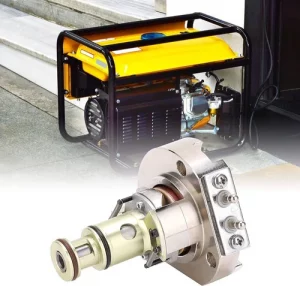
HOW DO I ORDER THE CORRECT VOLTAGE REGULATOR FOR MY GENERATOR?
The best and easiest way to insure that you get the correct voltage regulator is to get the numbers off of your old regulator. If these numbers are unreadable, or if your old regulator is manufacturer discontinued, we can cross reference the generator model to the correct regulator for your application.
HOW DO I ORDER THE CORRECT GENERATOR END FOR MY ENGINE
The generator end needs to bolt up to both your engine and to the engines flywheel. Engine and flywheel bolt patterns are standardized by the Society of Automotive Engineers (SAE). You need to supply us with the SAE sizes for your engine’s bolt pattern which we call the “engine adapter”, and for the flywheel which we call the “engine coupler”. These two sizes are critical to getting the correct generator end. If either of them is incorrect, then the generator end won’t fit.
The best way to obtain the SAE sizes for the engine and flywheel is to measure them, and compare those measurements to our cross reference list to determine the proper size. Once you have the SAE numbers, all you need to do is choose a generator end that is compatible with the horsepower of your engine, at the voltage you’re using
WHAT KW RATING OF GENERATOR WILL MY ENGINE HANDLE
One horsepower equals .746 Kilowatts of electricity. Generators are only approximately 80% efficient at converting rotating energy to electricity. Therefore if you multiply .746 X .80 = .597 you’ll get the amount of electricity in KW that a one horsepower engine can produce. All industrial generator ends are rated for 60 hertz at 1800 RPM. If your engine for example will produce 25 horsepower at 1800 RPM, then you can realistically expect to be able to produce 14.9 kilowatts, (25 X .597 = 14.925) at full load.
Please note for calculation sake, I’ve used rated horsepower at full engine load. The generator end can safely continuously produce that amount of electricity, but I would caution would-be generator designers that running an engine continuously at a full load will result in a shortened lifespan (of the engine). I am very comfortable specifying continuous engine loading factors of around 80% for diesel prime movers and 60% for spark fired units. For standby units with varying loads, I see no problem rating at 100% horsepower capacity, as long as the average loading is in the 60-80% range or less depending on the engine type.
WHY DO YOU SHOW A LOWER KILOWATT RATING AT 120/240 VOLTS THAN AT 277/480 VOLTS
Generator ends are made of wire wound around the armature and the stator. This wire can only carry a certain amount of current, which is based on it’s size. It takes much less current to produce a kilowatt of electricity at 480 volts than it does at 240 volts, therefore the KW ratings of each model is less at lower voltages than it is at higher voltages.
WHAT IS A 12 LEAD RECONNECTABLE GENERATOR
A 12 lead reconnectable generator has 12 leads coming from it. You can connect these 12 leads in various configurations to produce any of the voltages that are commonly used in the United States.
WHY SHOULD I BUY A NEW GENERATOR END INSTEAD OF HAVING MY OLD ONE RE-WOUND
Rewinding your old generator end is a viable option. The only problem is that you’ll pay probably around 75-80% of the cost of a new generator end to have your old one rewound. You’ll also have to wait for the local generator shop to get the job done, and hope they do it right. When the job is done, you’ll still have an old generator end, and an old voltage regulator. If you buy a new generator end, you’ll have just that, a brand new generator end, a new voltage regulator, and a new factory warranty, if something does go wrong.